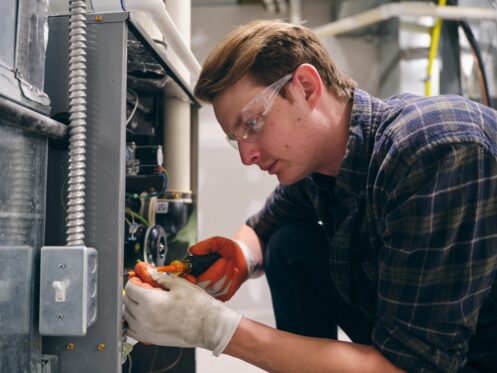Knowing when a furnace should be replaced is important for keeping your home sufficiently warm and reducing the risk of the unit suddenly giving out during the winter. Replacing your furnace before it finally dies will give you more time to select the right equipment for your home and ensure you’re not left without heating for any length of time. In this article, we’ll discuss approximately how long you can reasonably expect a furnace to last and all the factors that can affect its lifespan.
Average Lifespans for Gas and Electric Furnaces
As with any piece of equipment, the lifespan of a furnace can vary drastically based on a variety of different factors. The brand of the furnace is important since some manufacturers produce much higher quality, more durable units that last longer than other brands. How much use the furnace gets is obviously another important factor. How often the unit is inspected and serviced will also play a major role in how long the furnace lasts.
Gas furnaces usually last around 15 years, but some units may only last half as long while others could keep working effectively for 20 years or more. Electric furnaces typically have a longer lifespan and may work for 20 to 30 years. Despite the longer lifespan, electric furnaces aren’t always the best option, as they use a large amount of electricity. An electric unit will be cheaper to install, but you’ll pay much more in the long run than you would with a gas furnace.
How the Type of Furnace You Choose Can Impact Its Life Expectancy
Another factor that can determine how long a furnace will last is whether it’s a standard, single-stage unit or a two-stage or modulating unit. Single-stage furnaces are the cheaper option upfront, but they’ll often have a shorter lifespan. A single-stage furnace will also use more energy and lead to higher heating bills when compared to a two-stage or modulating unit. The reason is that single-stage units always have increased wear and tear due to them turning on and off all the time.
A single-stage furnace has only one speed or power setting. Two-stage furnaces obviously have two different speeds or settings, and modulating furnaces can have dozens of different settings. What this means is that a single-stage furnace can only ever operate at 100% power, so it always produces lots of heat and only ever needs to run for 10 to 15 minutes at a time. The issue is this leads to the temperature in the building constantly fluctuating so that the furnace typically never stays off for very long and usually needs to run two to three times an hour. Constantly cycling on and off puts much more strain on the furnace so that all of the components suffer more wear and tear.
A two-stage furnace will normally operate at medium power around 80% of the time, and it will heat around 30% to 40% slower when not running at full power. This means it won’t need to turn on and off as often, which not only keeps the temperature more consistent but also lessens the wear on the furnace. When running on medium power, the gas valve is only partially open, so less gas flows and less heat is produced.
Modulating furnaces are even better since they can reduce the heating rate so much that they run for long periods without turning on and off. While this may seem counterproductive, the fact is that it greatly reduces wear and tear on parts and also results in the home’s heating costs being much lower.
The issue with single-stage furnaces is that they often cause cold spots in a house. The thermostat is generally located in a central part of the home, and the areas near the thermostat will always be fully heated when the furnace shuts off. However, single-stage furnaces often don’t run long enough to fully heat rooms with exterior walls or areas farthest away from the furnace at the ends of the duct system.
This is where two-stage and modulating furnaces have a major advantage, as they’ll keep every room consistently warm while using less energy to do so. Both types will still heat at 100% capacity on occasion, but only when lots of heat is required. This typically only happens during extreme cold snaps or when the indoor temperature is quite a bit lower than whatever the thermostat is set to. For instance, if you program your thermostat to turn down to 60 degrees at night and then back up to 70 degrees in the morning, the furnace will run at full power until it brings the home up to temperature. Once the desired temperature is reached, the unit will typically switch off and run at a lower speed the rest of the time.
Why Regular Maintenance Is Essential for the Life of a Furnace
No matter what type of furnace you have, the biggest factors that will usually determine how long it will last are how often the unit is inspected and professionally serviced or maintained and whether any issues are repaired promptly. Another essential factor is whether you keep up with replacing or cleaning/changing the air filter regularly. If the air filter isn’t replaced every one to three months, it will start to limit the amount of air coming into the furnace. A lack of air coming into the unit will cause the heating system to produce much less heat and have to run longer. It can also lead to the furnace beginning to overheat and possibly suffering damage.
Regular maintenance is the best way to protect the longevity of your heating system and ensure you get as many years out of your equipment as possible. Every type of furnace should be fully cleaned, serviced, and inspected yearly. It’s best to have this done in the early fall before you need to run your heating system. Inspecting a furnace is obviously important for determining whether everything is in good shape and the unit is working effectively or if anything needs to be repaired or any components need to be replaced. It’s always important to have any necessary repairs done as soon as possible to reduce wear and tear and prevent any problems from worsening.
Cleaning the furnace blowers and the blower assembly is also essential for making sure the system heats effectively and for keeping the heating cycles shorter. The ports on the gas burners tend to get dirty and clogged up with dust and cobwebs when the furnace sits idle over the summer. If the burners are dirty, the gas often won’t fully combust, and the furnace will produce less heat. The blower also tends to collect lots of dust, which can prevent it from moving air as effectively.
Yearly maintenance is especially important if your furnace is still under warranty. If any of the parts fail due to a defect, the warranty will cover the replacement parts. However, the manufacturer will honor the warranty only if you have proof that the unit was annually serviced by a licensed, certified HVAC company.
Sam's Air Control is a full-service HVAC contractor offering professional furnace replacement and installation services in the Metuchen area. Our technicians also service and repair all brands and types of furnaces. We can help you get the most out of your heating system. Give us a call today to schedule an appointment for furnace maintenance.


